Charles Brooking is a fascinating and knowledgeable collector of architectural detail, The Brooking Collection of Architectural Detail, and as Surveyors we find his lifelong quest to collect British building details unique, informative and valuable and a collection that must be kept intact for years to come. If you need help and advice with regard to building surveys, structural surveys, structural reports, engineers reports, specific defects report, dilapidations or any other property matters please free phone 0800 298 5424.
The following is one of a series of interviews with Charles Brooking, Historic and Listed Buildings Detail Expert, The Brooking Collection of Architectural Detail and a Surveyor where we have recorded his comments and various aspects that have affected windows and doors and other collectibles. The interviews outline how his collection started and built over the years and gives an insight into the amazing architectural features housed in his fine collection.
Surveyor : What reaction do you receive when you want to rescue half a staircase?
Charles Brooking : Well, it can be difficult because of the issues of access, but, a staircase is something that's probably the hardest thing to rescue, because they use them through the demolition. I try to rescue them as it's a very important thing to show.
Surveyor: Do you have a staircase from Park Lane, London W1?
Charles Brooking : Yes one dating from probably 1780's, from Park Lane, London W1.

Rescue defined
Charles Brooking defines a rescue as saving a window or door or staircase that would be doomed.
Charles Brooking was a pioneer in the rescue of architectural detailing as many years ago it was very much considered a strange and an unusual past time to want to rescue old parts of buildings with everything new and shiny being so important.
Surveyor : What sort of building would the staircase have been in originally?
Charles Brooking : Grand houses in Park Lane , London . W1, adjoining the Hilton Hotel.
Surveyor : Which era are those?
Charles Brooking : That is very much early to mid-18th Century onwards, up until about 1820, that sort of design. Wonderful 1830/19th Century design, all in lead and I rescued an early 18th Century cast iron version too.

Surveyor : Would you class those as hopper heads?
Charles Brooking : Rainwater heads or hopper heads.
Surveyor : Rainwater heads, yes.

Charles Brooking : I also rescued items from a street just off Petticoat Lane, London, E1. Including a sort of loading bay, loading door to a cellar, it's a rear trap window, door to a basement, that's got this amazing moulded prismatic glass.
Surveyor : The aim of the prismatic glass was ...?
Charles Brooking : The aim of this glass was to reflect light into the basement.
Surveyor: Did it work?
Charles Brooking : Yes, it did quite well actually.
Surveyor: Did you rescue many leaded lights?
Charles Brooking : Yes including a rather a nice leaded light window from, I think it's Cheam Road, Sutton; from one of those splendid villas with turrets on the corners.
Surveyor : Please describe leaded lights.

Charles Brooking: Well, it's, I suppose it's an early form of Art Nouveau, you've got cut glass jewels in it, with a red and amber and fluted glass and other forms of textured glass from these houses, all built by the same builder on the Cheam Road, Sutton. A typical example was divided up into sections, which is really developed from the Arts and Crafts movement and the fashion for glazing bars and the other half of the window with some decoration to the corners.
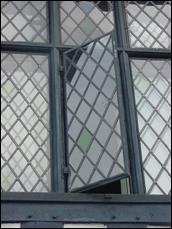
Please see our article on
Glass
Another window I rescued is a cotton frame window, or zinc, perhaps it's zinc, from one of the front doors in Richmond Terrace, Whitehall , London . SW1, built by Thomas Chawner in 1821 and was finished about 1840 to '45.
Another window I rescued was from, I think, a hospital building in Hampstead, London, with a louvre window, which is interesting and dates to about 1914.
Surveyor : A metal three louvred window?
Charles Brooking : Yes
Surveyor : Did you rescue any fanlights?
Charles Brooking : Yes rather a nice fanlight from Norwood in South London which is Regency with looped, or wrapped panes with rounded ends and amazing lead. This style was very common in the Regency era, but very elegant.
Surveyor : Rectangular overall?
Charles Brooking : Rectangular, yes. Came from one of those stucco villas, built in 1825 - 30 something, in that region.
Surveyor : You have rescued many sash windows too?
Charles Brooking : Yes including a top sash from Grosvenor Park, Southgate, designed by John Nash.
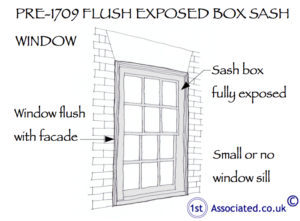
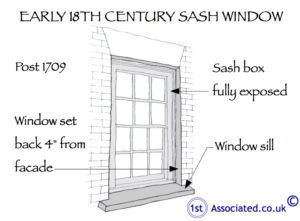
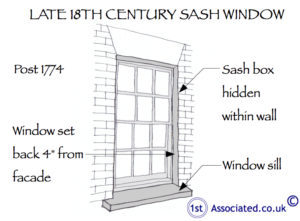
Please see our article on
Glass
Another window I rescued is a cotton frame window, or zinc, perhaps it's zinc, from one of the front doors in Richmond Terrace, Whitehall , London . SW1, built by Thomas Chawner in 1821and was finished about 1840 to '45.
Another window I rescued was from, I think, a hospital building in Hampstead, London , with a louvre window, which is interesting and dates to about 1914.
Surveyor : A metal three louvred window?
Charles Brooking : Yes
Surveyor : Did you rescue any fan lights?
Charles Brooking : Yes rather a nice fanlight from Norwood in South London which is Regency with looped, or wrapped panes with rounded ends and amazing lead. This style was very common in the Regency era, but very elegant.
Surveyor : Rectangular overall?
Charles Brooking : Rectangular, yes. Came from one of those stucco villas, built in 1825 '30 something, in that region.
Surveyor : You have rescued many sash windows too?
Charles Brooking : Yes including a top sash from Grosvenor Park , Southgate , designed by John Nash.
Charles Brooking : Yes from all over London including one from I think it was a double villa in Balham and another from a front, probably a bay window, that is rather fine.
My collection includes a fanlight design with, I suppose its Venetian glass, with a rather nice tint, all machine made, but well made and turn of the Century.
Surveyor : And again, rectangular overall, with a sort of semi-circular arc centrally positioned and, what would you say?

Charles Brooking : Well, it's a fanlight design with radiating panes and a central motif with a half a rosette on it, but actually machine made, probably on an early spindle mould of some sort, but it was probably part machine made, part handmade; it has a rather nice gun stop joint.
Surveyor : Please describe the leaded light window from the Alliance Corner house in The Strand, London ?
Charles Brooking : I rescued a leaded light from the Alliance Corner House in The Strand, which designed by F G Wills in 1912 and extended in the 30s. I rescued it when it was being demolished and you can see the Rene Mackintosh influence around the edge of the squares. It was still rotating this black out paint when I rescued it.

Surveyor : Please describe some other windows you have rescued in London?
Charles Brooking : I rescued a re-used top sash in a building about 1860, near Covent Garden, London. WC2. A sash from about 1785, which is a very high quality landing window with a Grecian ovelo moulding, arched head, central pane, probably laminated, steam bend; beautifully conceived and made.
Another rescue was a rather nice transom light with decorative glass and moulded glass in the centre, it has various colours around the border and was rescued from a building of about 1898, adjoining the Sutton Arcade in Sutton High Street.
Surveyor : Please describe the door you rescued from Lutyens House in Finsbury Circus, London EC2?
Charles Brooking : I rescued a door from Lutyens House, Finsbury Circus, London EC2 , which was originally Britannic House, and was designed by Sir Edwin Lutyens in 1924 being finished in 1929. I have in my collection one of the office doors which was beautifully made with stippled glass in copperlite glazing and I have the Lutyens astragal mouldings too that was a major rescue.
Surveyor : Is the door heavy?
Charles Brooking : Yes, very heavy, the building was partly demolished in the late 1980s for reconstruction a member of the Lutyens Trust highlighted this to me enabling me to carry a very interesting rescue there retrieving a lot of material.
Surveyor : Please explain more about the Lutyens Trust?
Charles Brooking : Well, it's a trust dedicated to Edwin Lutyens and his work.
Surveyor : Please tell me about the Voysey door?

Charles Brooking : Well I rescued a door designed by Charles Voysey from the Suffolk Mutual Benefits Society, their office dates to about 1906. You can see the Arts and Crafts revival carefully wrought iron hinge period.
The CFA Voysey Society
Architect Francis Annesley Voysey
Website VoyseySociety.com
Surveyor : You have a delightful narrow window in your collection where did it come from?
Charles Brooking : I have a narrow window made by Hoskins, who made steel windows in Birmingham it came from the Regal Cinema, Brighton Road, Purley and dates to about 1932, or something like that, and it's got the rather nice with textured glass and series of blues at the top; the Art Deco chevron .
Surveyor : You have some fabulous examples of glass in your collection.
Charles Brooking : I have an example of a window from 63 Sandy Lane, Cheam, typical of the late Edwardian era using textures and obscure glass, with a frame possibly made by Wellsteads of Croydon.
I also have a rather nice circular pivoting window from the Treasury Building in Whitehall, London . SW1, designed by Brydon, built in the 1890's, between about 1895 and 1912. You can still see the blackout paint used during the War. Obscure light, it's quite an interesting survival.
Surveyor : Do you have any windows from St Paul 's Cathedral?

Charles Brooking : Yes a window from the lantern at St Paul 's Cathedral it's an early one from 1719, with the construction, they've actually made glazing bars in two stages to facilitate the mitring. So, that's made in one piece, where they've actually joined, actually done it in two sections to help with the construction.
Surveyor : Do you have any windows from Holborn?
Charles Brooking : Yes I rescued a sash window section from the Prudential Building , Holborn, designed by Sir Alfred Waterhouse. Very typical of his work, with that very fine construction, you can see the actual parting beams, actually made, that goes right through the headpiece.

Another rescue was a typical top sash, again mass produced in the late 19th Century this time from a villa in North London, with a variation of the arts, it's a Queen Anne revival influence.
Also in my collection I have items from the outskirts of London from Bexley, designed by G T Hind, from one of the London asylums built in the 1890's, lunatic asylums. It's got the original sash cord and they were concealed sash cords so the inmates couldn't hang themselves! I have a small one from under the stairs, that is very scaled down.
I have a nice top sash from houses near Vauxhall Bridge Road, a typical Regency top sash with margin lights, a turn circle and with very interesting curve work. When you think that was from just a terraced house, it's beautifully made isn't it?
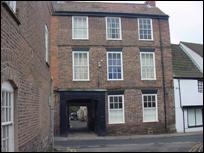
Surveyor : You have rescued many sash windows?
Charles Brooking : Yes, including one of the top sashes I rescued from Albany Terrace an arched one.
I rescued a section of a window from Horse Guards, designed by William Kent. I recovered a lot of material from there where they took out, quite incorrectly, the original sash windows.
Surveyor : Again, it wasn't Listed?
Charles Brooking : It was Listed but the surveyor arranged for the windows to come out and he was just over zealous and took out some important things that never should have come out!
I have a very early sash window section from 7 Greenwell Street, London. W1 re-used in 1793 by the builder of this house, which was built in 1793. The actual sash box section is probably 1700/1720, and was re-used in the house for cheapness in the basement. That was the home of John Flaxman, the famous sculptor, up until 1826, when he died.
In my collection I also have a very high quality, early 19th Century door from, probably from a house in the West End . It was re-used in a house in Brook Street, Mayfair, London. W1; Handel 's house, but it came from somewhere else. It's more like 1800/1810, beautifully made, with original door fittings and an original mortice lock.

Surveyor : Were you driving by the time you rescued that huge door?
Charles Brooking : I brought that back by van.
Another rescue I had delivered from the Regent Palace Hotel, designed, again, by F G Wells and built for the Lions Company, just of Piccadilly Circus, which is being currently rebuilt. That was Sir William McAlpine, which was marvellous.
I have a window from the German Gym in Kings Cross, London . N1. That is a bull's eye window, probably made by the St Pancras Iron Foundry.
Another window I rescued is from the atrium interior light well of Admiralty Arch, designed by Aston Webb in 1905/1911.
I rescued a window here the Lloyds Building, Leadenhall Street, London . EC3 which is copperlite and designed by Edwin Cooper and a top sash from the Peter Jones store, the 1890's section, with original glazing, by William Willett.
Another fanlight I rescued is from Riddell House and is a copperlite fanlight. Again designed by Edwin Cooper, St Thomas ' Hospital.
Surveyor : Where was that located?
Charles Brooking : St Thomas ' Hospital, is really just over the River Thames from Westminster, facing the Houses of Parliament on the opposite bank, but they've put a new building up there in recent years, it's won an award I think.
I have rescued a part of one of the internal doors from Windsor Castle, 1825, given to me shortly after the fire.

Surveyor : Did the door have fire damage?
Charles Brooking : It did. They couldn't restore it, so they copied it, because it was so badly charred on the other side.
Another rescue I saved a curved fan window from flats in Pascal Street, Wandsworth, London. SW8, which was built about 1936, which is made by the Rustproof Metal Window Company, Chester . This is an early example of galvanised windows, and an interesting two light window from Mountbatten 's private suite in Brook House, Park Lane, London. W1. built in 1936, or '32 to '36.
I rescued a wonderful fireplace from Bridgewater House, St James's, London. SW1 1880's refit and a lovely aesthetic movement, made by Jess and Bishop Barnard of Norwich, from the General Trading Company in Sloane Street, SW1, circa 1875, that wonderful arts and craftsman.
I have a fireplace I rescued from no. 6 Belgrave Square, London . W1 circa 1825.
Surveyor : Do tell me about some of your other rescues?
Charles Brooking : I rescued a wonderful grate from a building that was demolished in the late 1970s and it was a major rescue; I cut out a lot of fanlights and details. This was from one of the first big Georgian rescues I did at that period.
Surveyor : You made many rescues all across London .
Charles Brooking : Yes, London has always had a wealth of buildings of all ages, types and styles and with the building landscape ever changing demolishing buildings with new ones appearing seemed to be an ever evolving trend. I have a fanlight from the Mansion House, Walbrook, London . EC4 part of Bunning 's work to the building dating to the 1840's.
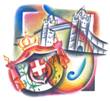
Another rescue was a cast iron window from the Public Records Office, dated 1854, and it's got cathedral glass in it, that's on loan from The Crown.
Surveyor : Please explain cathedral glass?
Charles Brooking : It's really an obscure glass, I don't know how to describe it really, but it's got a, it's almost like a surface, rather like the surface of ice, almost.
Surveyor : It is, it is a good example.
Charles Brooking : It has a nice copperlite panel with cromo plated glazing bars.
In addition I rescued a Victorian window, about 1840 to 50 from The Tower of London, Tower Hill, London . EC3 which was being replaced by a double glazing company and was designed by Salvin .
Surveyor : Replaced, was it timber double glazing they replaced it with?
Charles Brooking : I'm not sure that it was! It was replaced in the early 1980s.
Surveyor : Plastic, replaced with plastic double glazing!
Charles Brooking : Amazing isn't it.
Surveyor : Absolutely amazing!
Charles Brooking : I rescued a triple sash which is quite interesting, showing the box mullions which was rescued from Barnet Hospital , which was originally a workhouse.
Surveyor : A triple sash, you mean three?
Charles Brooking : Yes, three joined together.
Surveyor : Three, so wide, wide.
Charles Brooking : Wide, yes.
Another find was a rather fine carved bracket from Aubrey Rd , London W8, dating to approximately1717.
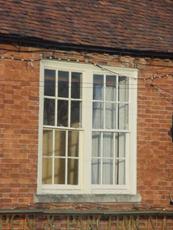
Double sliding sash window.
A triple sash has three!
If you found this article on The Brooking Collection of Architectural Detail interesting you may also be interested in the following articles on our website:
Mortgage Valuation surveys?
Victorian Properties and their common problems
Windows and The Great Fire of London
Unhealthy alliance between estate agents and surveyors
Why you have never seen a building survey or structural survey like ours
References: TheBrookingCollection.com DartfordArchive.org.uk IHBC.org.uk ProjectBook.co.uk
Independent Surveyors
If you truly do want an independent expert opinion from a surveyor with regard to building surveys, structural surveys, structural reports, engineers reports, specific defects report, dilapidations or any other property matters please contact 0800 298 5424 for a surveyor to give you a call back.
Commercial Property Surveyors
If you have a commercial property, be it leasehold or freehold, then you may wish to look at our Dilapidations Website at www.DilapsHelp.com and for Disputes go to our Disputes Help site www.DisputesHelp.com. We hope you found the article of use and if you have any experiences that you feel should be added to this article that would benefit others, or you feel that some of the information that we have put is wrong then please do not hesitate to contact us (we are only human). The contents of the website are for general information only and is not intended to be relied upon for specific or general decisions. Appropriate independent professional advice should be paid for before making such a decision.
All rights reserved
All rights are reserved the contents of the website are not to be reproduced or transmitted in any form in whole or part without the express written permission of

